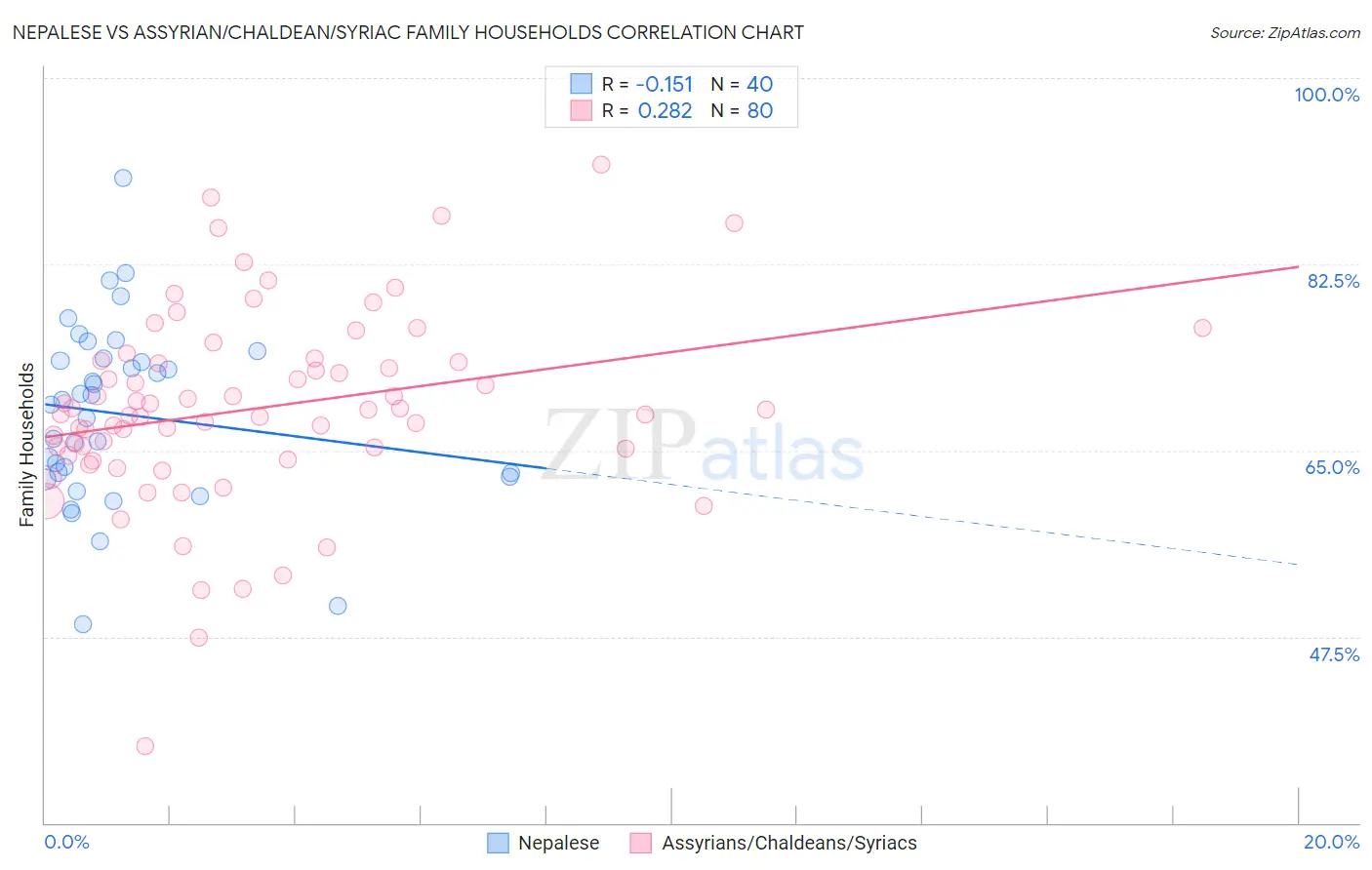Nepalese vs Assyrian/Chaldean/Syriac Family Households
COMPARE
Nepalese
Assyrian/Chaldean/Syriac
Family Households
Family Households Comparison
Nepalese
Assyrians/Chaldeans/Syriacs
67.2%
FAMILY HOUSEHOLDS
100.0/ 100
METRIC RATING
32nd/ 347
METRIC RANK
68.2%
FAMILY HOUSEHOLDS
100.0/ 100
METRIC RATING
15th/ 347
METRIC RANK
Nepalese vs Assyrian/Chaldean/Syriac Family Households Correlation Chart
The statistical analysis conducted on geographies consisting of 24,521,755 people shows a poor negative correlation between the proportion of Nepalese and percentage of family households in the United States with a correlation coefficient (R) of -0.151 and weighted average of 67.2%. Similarly, the statistical analysis conducted on geographies consisting of 110,294,582 people shows a weak positive correlation between the proportion of Assyrians/Chaldeans/Syriacs and percentage of family households in the United States with a correlation coefficient (R) of 0.282 and weighted average of 68.2%, a difference of 1.4%.

Family Households Correlation Summary
| Measurement | Nepalese | Assyrian/Chaldean/Syriac |
| Minimum | 48.7% | 37.2% |
| Maximum | 90.6% | 91.9% |
| Range | 41.9% | 54.6% |
| Mean | 68.4% | 69.0% |
| Median | 69.5% | 68.6% |
| Interquartile 25% (IQ1) | 62.7% | 64.9% |
| Interquartile 75% (IQ3) | 73.5% | 73.4% |
| Interquartile Range (IQR) | 10.9% | 8.5% |
| Standard Deviation (Sample) | 8.5% | 9.1% |
| Standard Deviation (Population) | 8.4% | 9.0% |
Demographics Similar to Nepalese and Assyrians/Chaldeans/Syriacs by Family Households
In terms of family households, the demographic groups most similar to Nepalese are Salvadoran (67.2%, a difference of 0.040%), Immigrants from Latin America (67.2%, a difference of 0.060%), Immigrants from Peru (67.2%, a difference of 0.070%), Nicaraguan (67.4%, a difference of 0.25%), and Hawaiian (67.4%, a difference of 0.32%). Similarly, the demographic groups most similar to Assyrians/Chaldeans/Syriacs are Immigrants from Vietnam (68.2%, a difference of 0.0%), Chinese (68.1%, a difference of 0.040%), Immigrants from Cuba (68.2%, a difference of 0.060%), Pueblo (68.2%, a difference of 0.070%), and Immigrants from Taiwan (68.0%, a difference of 0.20%).
| Demographics | Rating | Rank | Family Households |
| Pueblo | 100.0 /100 | #13 | Exceptional 68.2% |
| Immigrants | Cuba | 100.0 /100 | #14 | Exceptional 68.2% |
| Assyrians/Chaldeans/Syriacs | 100.0 /100 | #15 | Exceptional 68.2% |
| Immigrants | Vietnam | 100.0 /100 | #16 | Exceptional 68.2% |
| Chinese | 100.0 /100 | #17 | Exceptional 68.1% |
| Immigrants | Taiwan | 100.0 /100 | #18 | Exceptional 68.0% |
| Samoans | 100.0 /100 | #19 | Exceptional 67.9% |
| Inupiat | 100.0 /100 | #20 | Exceptional 67.8% |
| Cubans | 100.0 /100 | #21 | Exceptional 67.7% |
| Sri Lankans | 100.0 /100 | #22 | Exceptional 67.7% |
| Immigrants | Pakistan | 100.0 /100 | #23 | Exceptional 67.7% |
| Immigrants | South Eastern Asia | 100.0 /100 | #24 | Exceptional 67.5% |
| Immigrants | Nicaragua | 100.0 /100 | #25 | Exceptional 67.5% |
| Immigrants | India | 100.0 /100 | #26 | Exceptional 67.4% |
| Hispanics or Latinos | 100.0 /100 | #27 | Exceptional 67.4% |
| Hawaiians | 100.0 /100 | #28 | Exceptional 67.4% |
| Nicaraguans | 100.0 /100 | #29 | Exceptional 67.4% |
| Immigrants | Peru | 100.0 /100 | #30 | Exceptional 67.2% |
| Immigrants | Latin America | 100.0 /100 | #31 | Exceptional 67.2% |
| Nepalese | 100.0 /100 | #32 | Exceptional 67.2% |
| Salvadorans | 100.0 /100 | #33 | Exceptional 67.2% |